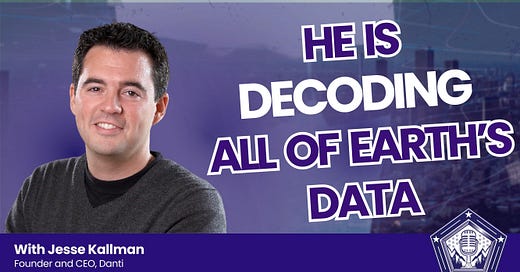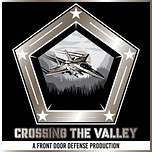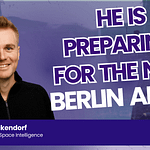About Jesse
Jesse Kallman is the founder and CEO of Danti, bringing deep industry experience from his extensive career in the defense and space sectors. With a strong background in unmanned systems and Earth observation, Jesse has worked at major defense primes including Booz Allen Hamilton, Northrop Grumman, and Airbus, giving him a comprehensive understanding of both the technical and operational aspects of intelligence analysis.
Throughout his career, Jesse has advised executives at Fortune 500 companies, members of Congress, and even the White House on matters related to drone technology and remote sensing. Unlike many defense tech founders who position themselves as outsiders disrupting the establishment, Jesse leverages his insider knowledge and industry relationships to create solutions that complement existing systems while addressing their most significant limitations. His approach emphasizes partnership, recognizing the value that established defense contractors bring to the table while identifying areas where innovative software can dramatically improve outcomes.
About Danti
Founded just over two years ago, Danti is building what Jesse describes as a "search engine for Earth observation data." The company's core technology is an AI-powered knowledge engine that helps users discover, analyze, and utilize vast quantities of information captured from diverse sources including satellites, drones, social media, news, and analyst reports.
Danti's platform addresses a critical bottleneck in intelligence analysis: the growing gap between the volume of available data and the number of experts who deeply understand how to use it. By encoding domain knowledge and tradecraft into software, Danti enables users of all skill levels—from 15-year expert analysts to deployed service members in the field—to effectively work with multimodal, distributed information.
The company has gained significant traction with government customers, winning contracts with agencies such as the National Geospatial-Intelligence Agency (NGA) and the Space Force. What sets Danti's approach apart is its emphasis on multi-INT (multiple intelligence sources) analysis, recognizing that most real-world problems require synthesizing information across different modalities rather than relying on a single data type.
Rather than forcing organizations to adopt an entirely new system, Danti is designed to integrate flexibly into existing workflows. For some users, particularly those at the tactical edge with limited reach-back capabilities, it can serve as an end-to-end solution. For others, especially expert analysts with established tools, Danti can function as an API or accelerator for specific workflow segments, enhancing rather than replacing their current systems.
With a team of approximately 20 people—primarily engineers—Danti has maintained a capital-efficient approach while delivering capabilities used by hundreds of analysts across government agencies. The company is now focused on scaling from pilot programs to enterprise-wide deployments.
Key Takeaways
The Multi-INT Imperative: Single data modalities rarely solve complex problems. As Jesse explains, "Some problems can be solved by a satellite image. They can be solved by a drone ISR feed. They can be solved by a tweet that someone posted with a video online at the perfect time and place." However, most significant challenges require synthesizing multiple intelligence sources. Danti solves information silos by creating a unified knowledge engine that understands relationships across all modalities, enabling analysts to ask natural language questions without needing to specify the perfect data source. This shift toward multi-INT analysis represents a fundamental evolution in how both defense and commercial organizations approach data-driven decision making.
The Opportunistic Origin Story: Danti's journey began with fortuitous timing: the NGA released a challenge called G-Search focused on next-generation imagery search capabilities just as they were preparing to start the ocmpany. "We were like a week or two away from starting the company... The product barely existed. It was just like some cobbled together thing that we had as a demo," Jesse recounts. Despite having only a rudimentary prototype, they entered the competition and won, securing a contract that provided not only funding but invaluable customer discovery. This early engagement with NGA accelerated their development timeline and connected them with potential customers across multiple agencies.
Partnership Over Disruption: Unlike many defense tech startups that position themselves in opposition to established contractors, Danti has embraced a partnership approach with defense primes. Jesse articulates this strategy clearly: "It's typically a really bad strategy for someone to come in and say, 'I know better than all these people.' They may be coming with a very different technological approach, but that's usually very complementary to what a lot of these people are doing." This philosophy stems from Jesse's recognition that primes offer critical advantages—established customer relationships, contract vehicles, and deep domain expertise. Rather than trying to displace these companies, Danti seeks to enhance their capabilities, often serving as a subcontractor on existing programs. This approach has enabled the company to access customers more quickly than would otherwise be possible, while focusing engineering resources on product development rather than navigating procurement processes.
Flexible Integration Strategy: Instead of forcing a one-size-fits-all approach to product integration, Danti has embraced flexibility in how customers deploy their technology. As Jesse explains, "We would love to be an end-to-end system for the vast majority of not your highly skilled geospatial analysts, signals analysts, OSINT analysts, but your deployed service member in the field." For these tactical users, Danti can serve as a complete solution. However, for expert analysts with established toolsets and workflows, Danti functions more as a component that enhances specific capabilities—perhaps providing rapid data discovery at the beginning of a process or enabling faster analysis in the middle. Different user personas have different needs and technical environments.
The Rising Consortium Model: Jesse identifies an emerging trend in the defense tech ecosystem: increased collaboration among startups that might traditionally view each other as competitors. "What I've been seeing is more of this multi-INT and also multi-company approach to a lot of problems. We partner with a lot more even startups and larger companies... We can be a piece. And now these are the other four missing pieces, but together we can actually solve the entire problem end to end." This consortium approach represents a maturation of the defense innovation landscape, moving away from the early days when each company tried to position itself as a comprehensive solution. By combining complementary capabilities, these emerging partnerships can present more compelling offerings to government customers while allowing individual companies to maintain focus on their core strengths.
For more on Danti: https://danti.ai/
For more on Jesse: https://www.linkedin.com/in/jessekallman/
For more Crossing the Valley: YouTube | Substack | LinkedIn | X












Share this post